Solar power is at a unique place in history. It’s growing rapidly, its price is falling precipitously. Within the next 10 years, it will compete favorably with utilities for electricity sales, on price, and without subsidies.
Given its rapid ascent, it might seem silly to talk about change. But the continued expansion of distributed solar power may rely on modifying a bedrock of distributed solar policy.
The Past
The solar past is all about net metering (and generous federal, state and utility incentives), a policy allowing smaller scale arrays (usually 1 megawatt or smaller) to connect to the grid at low cost, and for that solar energy to be credited to the producer’s electric bill as though it were a comparable amount of energy conservation. If a solar array produces 100 kilowatt-hours (kWh) in a month and the customer uses 300 kWh, then the customer’s bill is for the “net,” 200 kWh.
Why Net Metering Is Awesome
- Typically reduces or eliminates extraneous fees on producing local energy
- Standardized tariff – same deal for everyone
- Easy to understand compensation
- Tax free energy production, because it is “paid” as an energy credit, not cash
- Customer doesn’t need a battery because net metering is an accounting policy, not an electrical engineering one
Why Net Metering Isn’t Everything
- You can’t produce more than you consume. If you’re a commercial warehouse with roof space for 2 megawatts of solar but very little on-site demand, it’s not economical to fill the roof with solar panels.
- Compensation was historically much less than the actual value of solar to the utility, its customers, and society.
- The customer may have a perverse incentive to increase electricity consumption because compensation is much less for energy produced in excess of consumption.
The following chart explains how net metering laid the financial foundation for solar PV projects, but that incentives had to make up the difference. It also illustrates how, based on the preliminary estimates of the value of solar from Minnesota‘s new policy, utility compensation for solar energy produced under net metering was likely far less than the actual value of that energy (unless the utility also offered rebates or incentives).
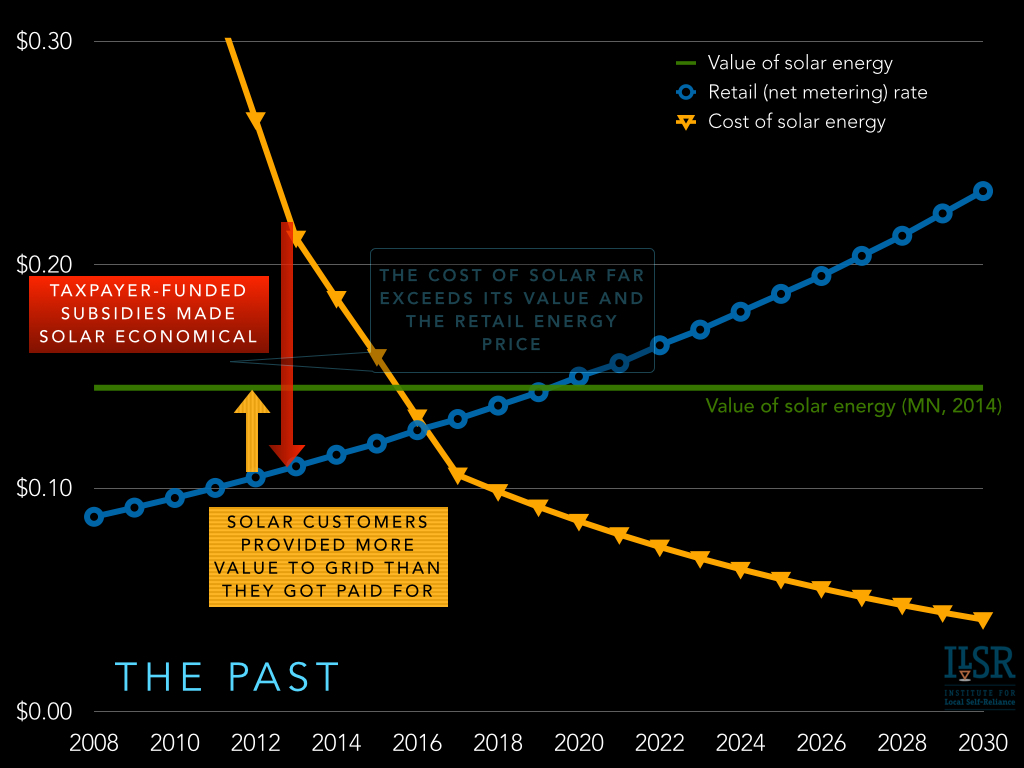
The Present
By the end of 2013, the U.S. had installed 13,000 megawatts (MW) of solar PV systems, and net metering contributed to a huge portion. The cost of installing solar had fallen 60% in five years and, in certain parts of the country, the cost of a solar array averaged over 25 years of energy production (called the “levelized cost”) had dropped below the price many customers paid to the utility per kWh. The following chart illustrates, with the levelized cost data for Missouri (about average for the U.S., but much above the cost in sunny areas like California or Colorado).
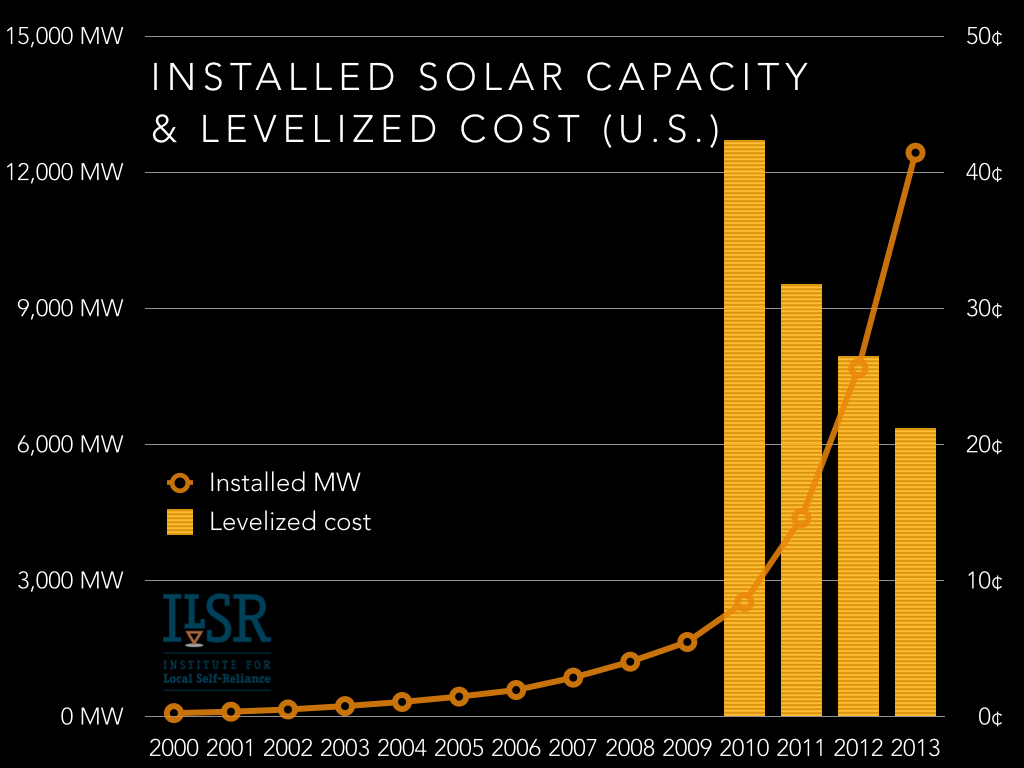
The growth in solar power and falling prices have led to a new dynamic in solar economics. For the first time in many places, solar electricity from the rooftop is cheaper than utility-provided power – without subsidies! And in particularly sunny places, the levelized cost of solar may even be below the “value of solar,” meaning that solar energy producers (if paid this value) could make a return on investment just on these merits. This “present” phenomenon will take place in different regions of the country at different times, but will happen everywhere within 5-7 years.
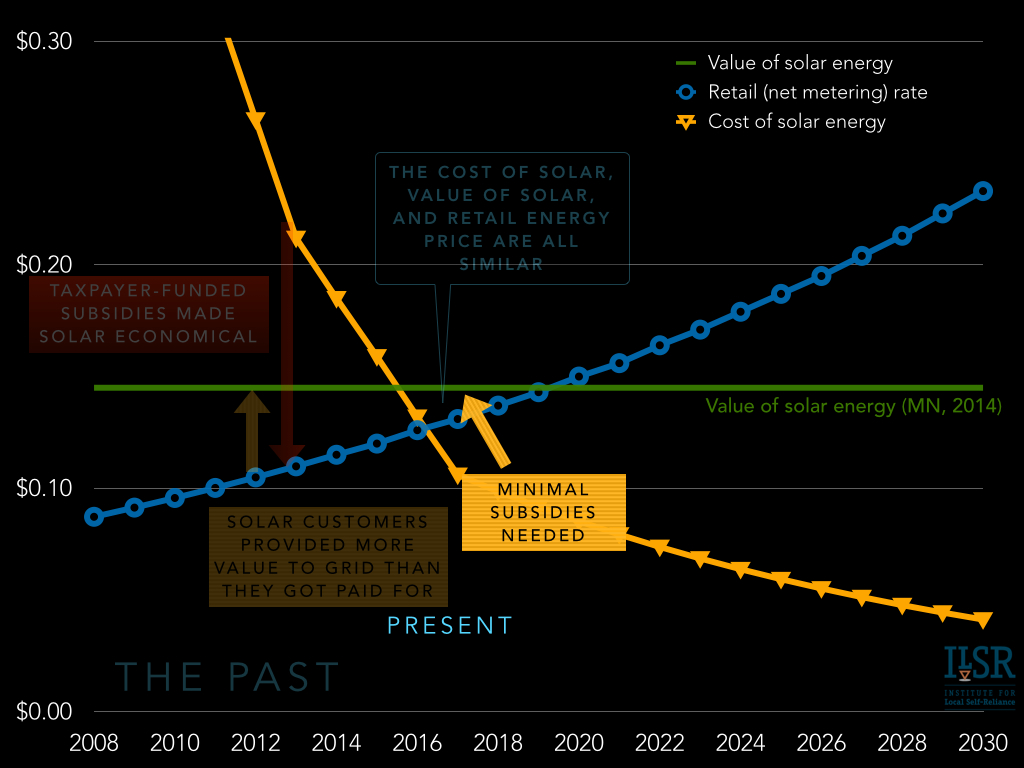
What’s important to note is that there’s a convergence: the retail electricity price, the value of solar, and the levelized cost of energy from solar panels are all relatively close.
It also means that by historical accident, net metering rates now and in the near future are very close to what solar energy is worth to the grid. And, it may mean that no incentives (local, state or federal) are needed to finance a solar project.
The Future
With a repeated nod toward the success of net metering and other incentives at building a growing solar market (at least in some regions of the U.S.), the future portends significant political problems if the policy prescription remains unchanged. The three key economic drivers of solar (the net metering rate, the value of solar, and the cost of solar) that have recently converged will begin to diverge rapidly. The following graphic illustrates the phenomenon that first strikes states with high electricity prices and abundant sunshine (already), but eventually spreads everywhere (in the next 10-15 years):
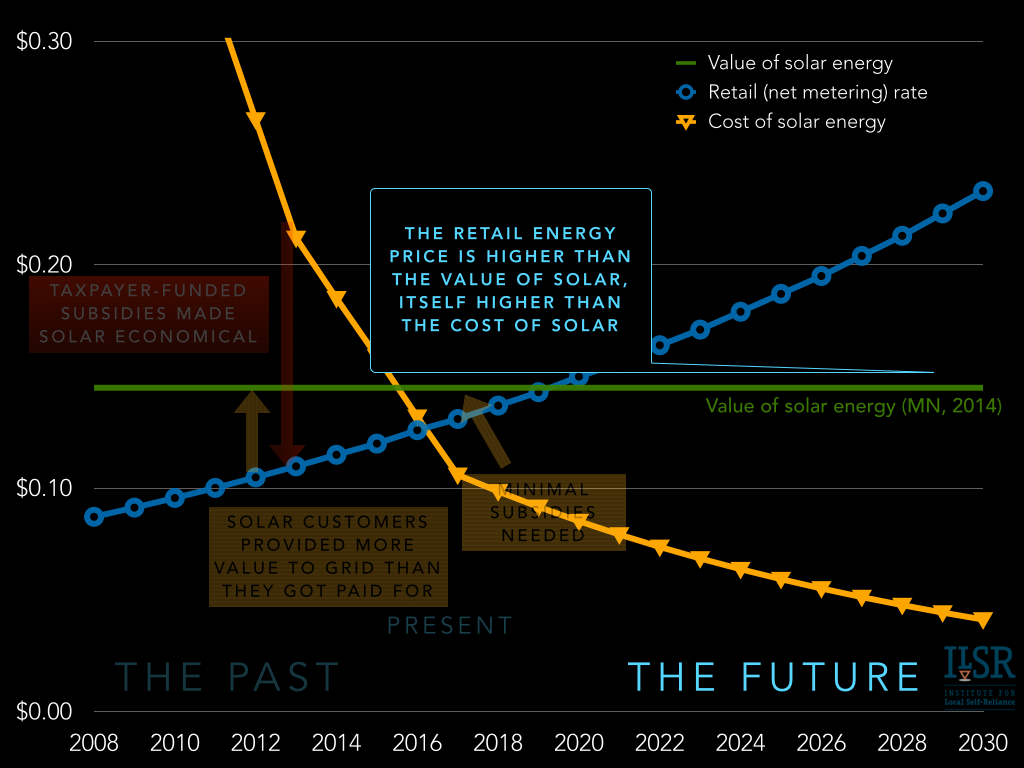
What does this divergence mean? Net metering will become increasingly lucrative for solar energy producers. For example, if Germany used net metering instead of a feed-in tariff policy, customers with solar arrays would be paid $0.30 per kWh for solar energy that cost less than $0.13 per kWh to produce, a 130% profit margin!
Big profit margins for solar producers is a novelty, but bad policy. First, it’s economically inefficient to pay so much more than is necessary to shift the grid to solar energy. Arguably, a 13% profit margin rather than 130% could move enormous numbers of utility customers to local solar energy. Second, when using net energy metering policy and paying a retail energy rate that is higher than the value of solar, it means that electricity customers as a whole are paying more for solar energy than its worth (assuming that the calculated value of solar is accurate). Finally, it’s inequitable. More than 75% of residents don’t own a suitable sunny rooftop for solar energy. If solar producers are getting over-sized profits, it comes out of the pockets of those who can’t afford to go solar.
But the economics are secondary to the political implosion that results from poor policy. Americans overwhelmingly love solar energy because it represents self-reliance, clean energy, and local power. It means monopoly utilities (which they dislike) lose and they win. It’s a political punch that unites the Sierra Club and Tea Party in Georgia. And it’s gone in a hurry if the evidence suggests that solar is perpetuating an economic system of winners and losers.
Already, utilities are fighting back against net metering and other distributed solar policies on the suggestion that the problems illustrated above are happening now (see the map of states where distributed renewable energy is under fire below). They aren’t. Utilities fighting now are fighting for a 20th century model of centralized control and comfortable monopoly profits. But in a decade they’ll have the truth on their side and not just innumerable lawyers and lobbyists.
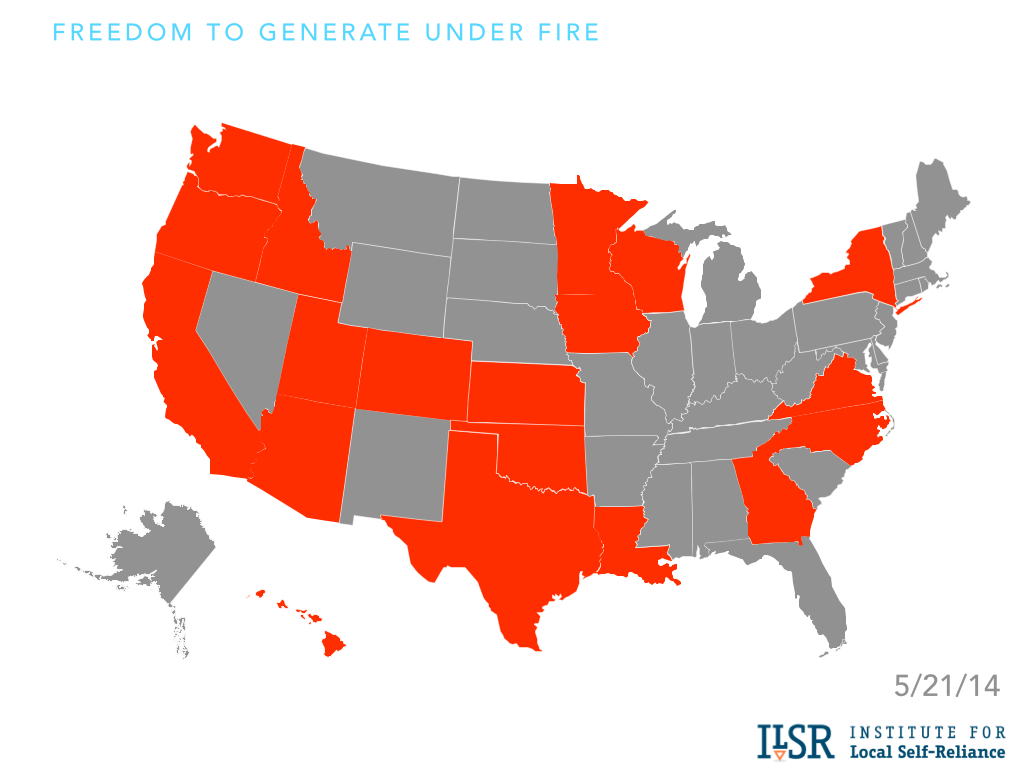
So, what needs to be done differently?
Fixing the Future
No matter the changes, it’s important that the future distributed solar policy embrace the same principle as net metering: democratic access to the means of producing local energy with reasonable and equitable compensation.
Possibilities
- The “value of solar” – change the form of compensation for on-site energy production from a per-kWh credit to a credit based on the true value of solar, as Minnesota has legalized. That state’s policy still uses the net metering framework (bill credits, matching production to onsite consumption) but changes the compensation from the retail energy rate to the transparent, calculated value of solar. Presuming the price is accurate, it can be enough to finance solar projects and hold non-participants harmless.
A Net Metering and Value of Solar Comparison
The following charts show how revenue from net metering and revenue from value of solar compare based on an actual 2.5 kilowatt (kW) solar array installed in Minneapolis. For a 2.5 kW solar array installed in 2014, the total revenue over 25 years is about $1500 more for net metering. For a solar array installed in 2020, the gap jumps to $5000. If the value of solar rate is an accurate representation of the actual value of solar to the grid, electric customers, and society, then the gap represents over-payment to solar energy producers.

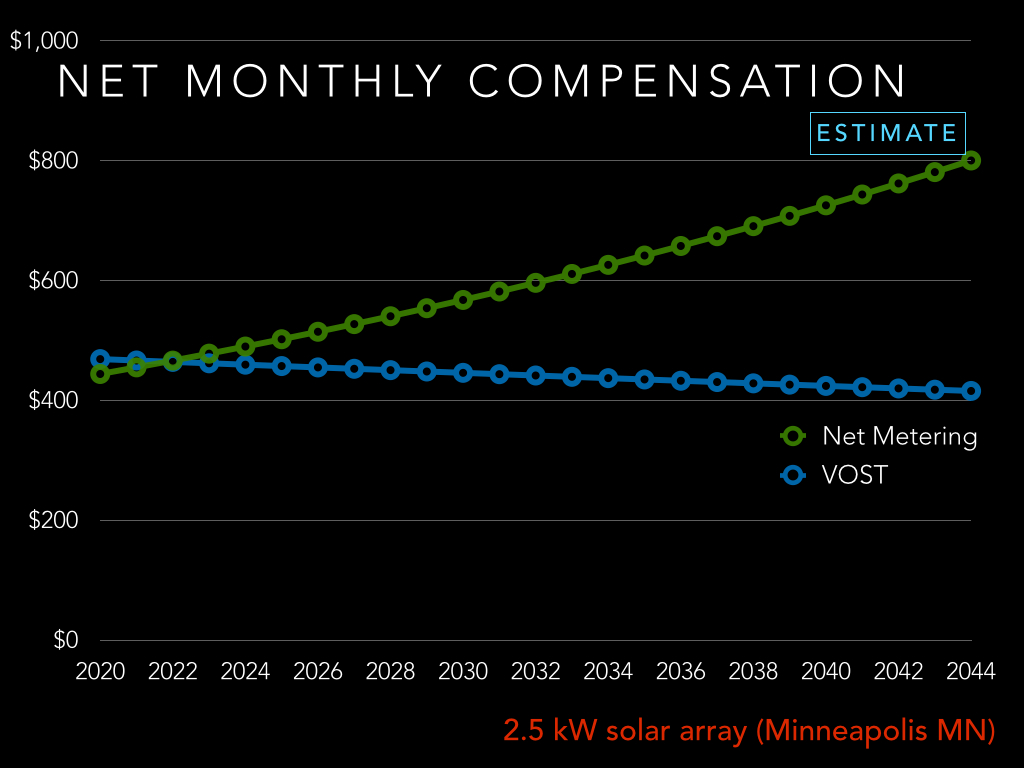
- A feed-in tariff or CLEAN program – go a step further than Minnesota (and join Vermont, Hawaii, and various utilities like Consumers Energy in MI, Palo Alto in CA, and others) and use a policy that completely separates energy consumption from production. Set a price to pay for solar energy that grows the market or based on its value (both have been tried). Producers still buy all their energy from the utility, but they get paid for all their production (and likely pay taxes on it – after all, it’s income).
- Something else entirely. Maybe 10 years from now battery storage is so cheap that everyone who has solar has one, and only excess power generation is sold to the grid at the value of solar. Or perhaps there’s community shared storage.
None of these ideas is the perfect fit for every state or every utility. And there are no doubt two other good policy concepts for each one I’ve listed here. But the future of solar energy will require a different approach than the past. And we’d best start thinking about what that future will be.
Photo credit: Satpal Singh









